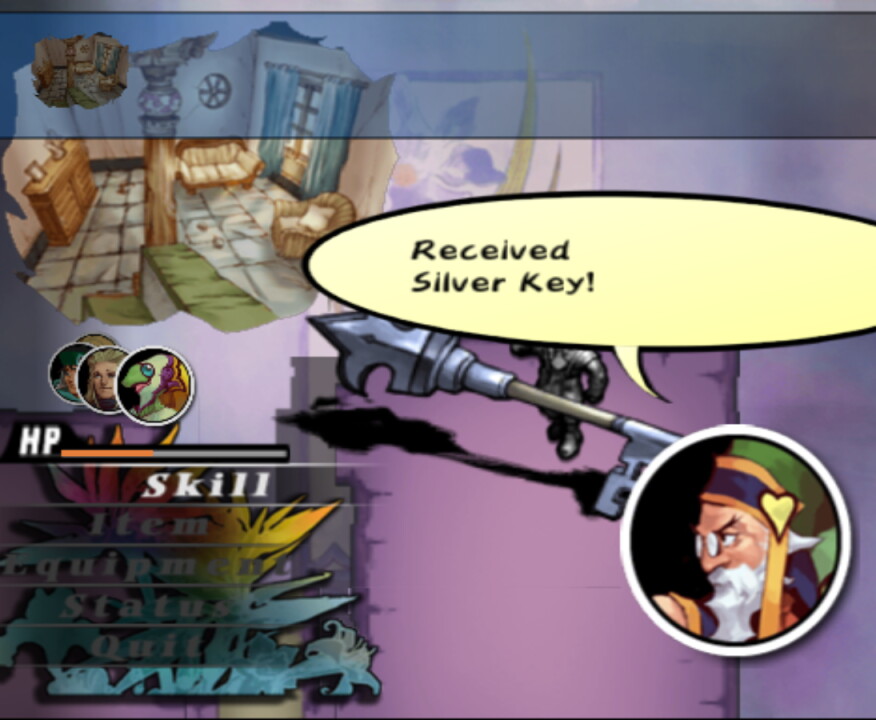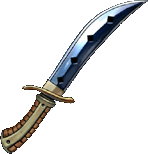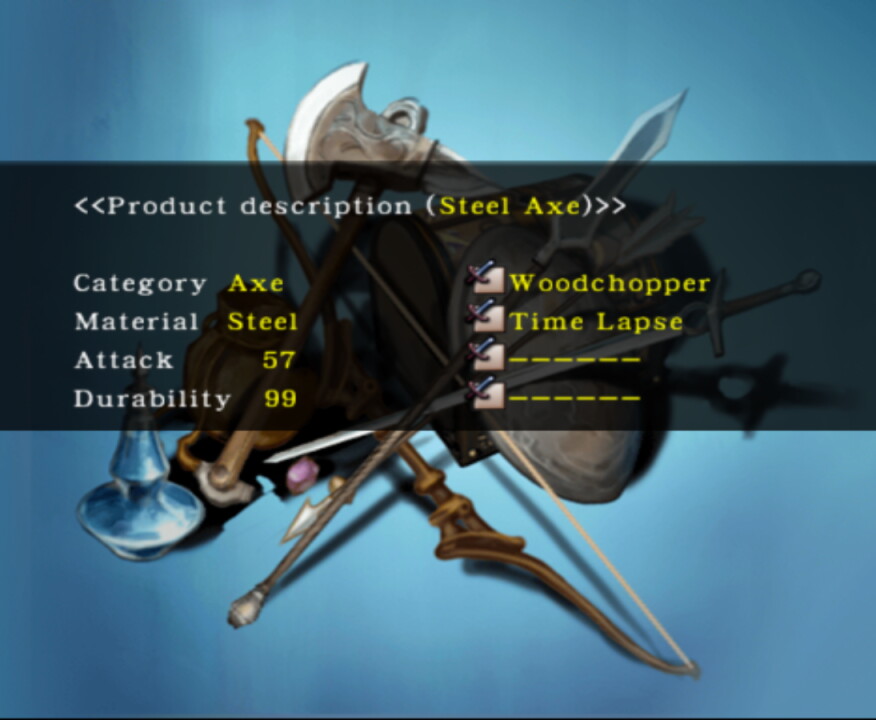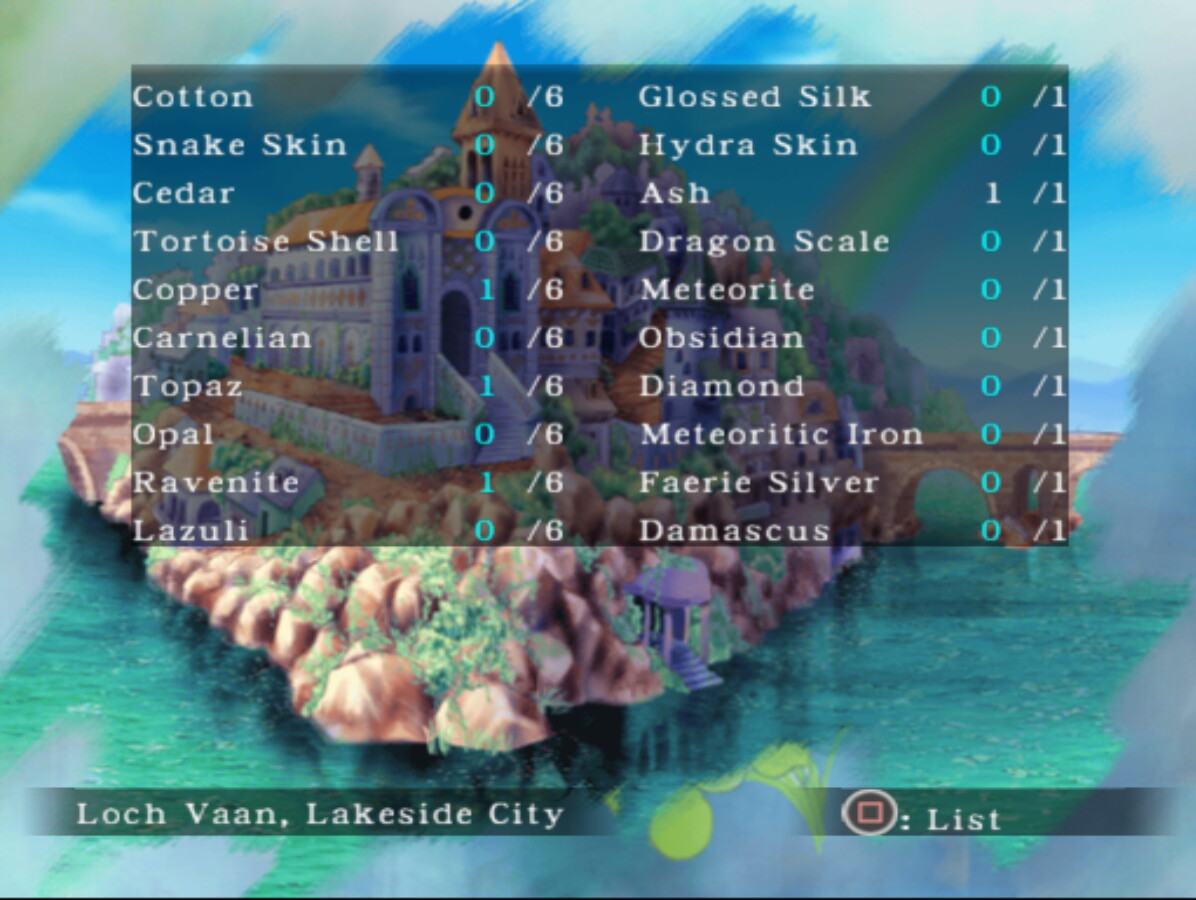-QuickNav-
[Item Types]
[Abilities & Ability Slots]
[Materials]
[Durability & Repairs]
Items & Equipment

Most items you find on your adventure will be used as Equipment for characters, or used at a Blacksmith to craft or repair characters' Equipment. Items can be obtained as treasures found while adventuring, sometimes found after battle, purchased or traded for while shopping, or crafted anew at a blacksmith. When acquired, items are placed in the inventory, which can hold a total of 99 items. If the inventory is full, it is not possible to obtain new items.
All items have a Type, which determines what it is used for, a Material, which describes what it is made from, and four Ability Slots which can contain Abilities. Items that can be used for action in battle will also have a Durability (EN) which will lower when used in battle. All Equipment items will also have some sort of Rating that determines their effectiveness and can be used to compare the relative strength or effectiveness between two items of the same Type.
In most menus where items can be browsed, an information window will be displayed that shows information about the currently highlighted item. The information window contains three pages of information: a General Information page that shows the item's Type, Material, and Rating, a Ability Information page that shows the item's four Ability Slots and any released Abilities, and a page with a Basic Description of the item.
A few items unrelated to Equipment exist, including Keys which can be used to unlock doors and contain the Locksmith Ability, and Herbs which can be used to heal Party Members and contain the Life Restorer Ability.
The Type of an item determines what it is used for and where it must be equipped in order to function properly and what kinds of Abilities it may have. You can see the Type of an item in the item's General Information page in most menus.
- Material

- Raw materials do not release Abilities or provide Defense on their own, but they may be used to craft and repair items at the blacksmith.
- Weapon

- Weapons are further divided into their individual Types: Dagger, Sword, Axe, Staff, Spear, Bow, and Gun. Weapons should be equipped to the first or second Weapon slot. They give access to Weapon Abilities that allow the use of Weapon Arts in battle. Weapons equipped to the first Weapon Slot will perform Arts slightly better than Weapons equipped to the second Slot. Some Weapons may also have a Parrying ability which allows it to deflect some attacks in battle when equipped to the second Weapon Slot. Weapons can be used to channel Magic Arts.
- Shield

- Shields must be equipped to the second Weapon Slot. Shields will block attacks based on their rating, the level of the user's Shield Arts Skill Panel, and the types of Evasion Abilities on the Shield. A Shield that hasn't released any Evasion Abilities yet cannot block anything. Shields can be used to channel Magic Arts.
- Accessory

- Accessories must be equipped to either of the two Accessory Slots. There is no difference between the two Slots. Accessories provide a small amount of Defense, and may contain many useful Abilities. Accessories can be used to channel Magic Arts.
- Headgear

- Headgear must be equipped to the Head Armor Slot. Head Armor often provides a small amount of Defense along with various passive support Abilities.
- Body Armor

- Body Armor must be equipped to the Body Armor Slot. Body Armor usually provides the greatest Defense rating of the various Armor Types. Body Armor is also likely to have many useful abilities such as Barrier Abilities or the Life Protection Ability.
- Leg Armor

- Leg Armor must be equipped to the Leg Armor Slot. Leg Armor often provides a small amount of Defense along with various passive support Abilities.
- Others

- Other Types exist, usually under specific circumstances, and are not found while shopping nor can they be crafted or repaired. These items include Keys, Herbs, and story-relevant items such as Magic Tablet Shards. Some of these items are made of a common material (such as a Key made of Copper) and can be used as a Material at the blacksmith.
Materials, Weapons, Shields, Accessories, and some Other Types may all be used as items for crafting or repairing at the blacksmith. When using an item at the blacksmith as an ingredient, the Type is not relevant, and the item will be treated as if it were a Material.
| Ability | Description |
|---|---|
| Null Poison | Grants immunity to Poison |
| Null Darkness | Grants immunity to Darkness |
| Null Petrify | Grants immunity to Petrify |
| Null Paralysis | Grants immunity to Paralysis |
| Null Blackout | Grants immunity to Blackout |
| Null Confusion | Grants immunity to Confusion |
| Heal+5 | Resting heals 5% more HP than normal |
| Heal+10 | Resting heals 10% more HP than normal |
| Heal-5 | Resting heals 5% less HP than normal |
| Heal-10 | Resting heals 10% less HP than normal |
| Heal-15 | Resting heals 15% less HP than normal |
| Heal-20 | Resting heals 20% less HP than normal |
| Heal-25 | Resting heals 25% less HP than normal |
| Ultra Heal | Character restores 50-100% of Max HP every turn, even when not resting. |
| Fire Arts | Channels Fire Arts |
| Earth Arts | Channels Earth Arts |
| Metal Arts | Channels Metal Arts |
| Water Arts | Channels Water Arts |
| Wood Arts | Channels Wood Arts |
| Forbidden Arts | Channels Forbidden Arts |
| Fire Support | Boosts Fire Arts |
| Earth Support | Boosts Earth Arts |
| Metal Support | Boosts Metal Arts |
| Water Support | Boosts Water Arts |
| Wood Support | Boosts Wood Arts |
| Forbidden Support | Boosts Forbidden Arts |
| Slash Evasion | Shield can block Slashing and Bludgeoning attacks |
| Pierce Evasion | Shield can block Piercing attacks |
| Physical Evasion | Shield can block Slashing, Bludgeoning, and Piercing attacks |
| Heat Evasion | Shield can block Hot attacks |
| Lightning Evasion | Shield can block Shocking attacks |
| HIL Evasion | Shield can block Hot, Cold, and Shocking attacks |
| ◎ Hit Barrier | Reduces damage from Bludgeoning attacks to the wearer by 10% + 10 HP |
| ◎ Heat Barrier | Reduces damage from Hot attacks to the wearer by 10% + 10 HP |
| ◎ Ice Barrier | Reduces damage from Cold attacks to the wearer by 10% + 10 HP |
| ◎ Lightning Barrier | Reduces damage from Shocking attacks to the wearer by 10% + 10 HP |
| ○ Slash Barrier | Reduces damage from Slash attacks to the wearer by 3% + 3 HP |
| ○ Hit Barrier | Reduces damage from Bludgeoning attacks to the wearer by 3% + 3 HP |
| ○ Pierce Barrier | Reduces damage from Piercing attacks to the wearer by 3% + 3 HP |
| ○ Heat Barrier | Reduces damage from Hot attacks to the wearer by 3% + 3 HP |
| ○ Ice Barrier | Reduces damage from Cold attacks to the wearer by 3% + 3 HP |
| ○ Status Barrier | Decreases chance of the wearer being inflicted with status effects during battle |
| ▲ Pierce Barrier | Increases damage from Piercing attacks to the wearer by 50% |
| Strength Saver | Prevents wearer's Strength Level from being lowered in battle |
| Skill Saver | Prevents wearer's Skill Level from being lowered in battle |
| Magic Saver | Prevents wearer's Magic Level from being lowered in battle |
| Endurance Saver | Prevents wearer's Endurance Level from being lowered in battle |
| Spirit Saver | Prevents wearer's Spirit Level from being lowered in battle |
| Life Protection | 5% chance to ignore each point of LP damage inflicted to wearer |
Abilities are qualities of items that enable them to perform actions in battle or provide passive support to characters in battle. All items contain four Ability Slots which may or may not contain Abilities. Abilities are hidden inside their Ability Slot until the Ability Slot is released. Once released, the Ability in an Ability Slot becomes visible and its effect can be used in battle. Before release, an Ability in an Ability Slot will not be visible and appear as if there is no Ability in the Ability Slot.
All items have four Ability Slots and the Ability Slots will all release in order from top to bottom. Even items that do not have any Abilities still contain four Ability Slots, and each Slot is considered released or unreleased. When crafting items at the blacksmith, the resulting item will have the same number of slots released as the base item, so the Ability Slots of items with no Abilities such as Materials will become relevant. The more Ability Slots released on an item, the higher its value on the market.
The four Abilities (or lack of Abilities), whether hidden or released, in the four Ability Slots of any item is referred to as that item's Ability Set. Because these are static and Abilities are not randomly generated when an Ability Slot is released, if you unrelease an Ability Slot on an item, you will release the same Ability when that Ability Slot is released again.
You can view the entire list of Abilities and their descriptions in the game by going to the Ability Help submenu of the Status Menu while on an Adventure. The list is somewhat misleading, however, as many Abilities that technically exist in the game never appear on any items. The list of only Abilities that appear in the game can be viewed in the table on the right side of this section.
Releasing Abilities

When obtaining an item for the first time, it will randomly have one or more of its Ability Slots already released. The first Ability Slot on any Item will always be released; it is impossible to unrelease it. Any unreleased Ability Slots may be released by equipping the item and participating in battle or by using the blacksmith. It is also possible to unrelease Ability Slots that are already released at the blacksmith, too, however. Ability Slots always release in order from top to bottom (first to fourth), and in the case of unreleasing, will also unrelease in the reverse order (bottom to top).
If an Item is equipped to a character and that character participates in battle, there is a chance that the item may release one of its Ability Slots at the end of battle if all four have not already been released. The more Ability Slots released on an item, the harder it is to release additional slots, meaning each slot will be harder to release than the last. At the end of a battle, if a new Ability Slot is released on an item that Ability Slot had an Ability hidden in it, there will be a notification at the bottom of the screen saying that the character successfully released an Ability. If a new Ability Slot is released during battle, but that Ability Slot did not have an Ability hidden in it, there will be no notification, even though the Ability Slot is released.
At the blacksmith, every time an item is crafted or repaired, the blacksmith has a chance to make a great success or a great failure, leading to an Ability Slot being released or unreleased. Using similar Materials for both the Base Item and Additional Item will make great success more likely, while using strange combinations of Materials will make great failure more likely. The blacksmith's reaction to the finished product will indicate the quality of work, regardless of whether or not a released Ability Slot had an Ability hidden in it.
Weapon Abilities
While not listed in the main list of Abilities, there are Abilities that are unique to Weapons. Weapons will always have a total of four Abilities, so each of their Ability Slots will always release an Ability. Most Weapon Abilities are the name of an Art or a type of Art, and they give access to certain groups of Arts called Ability Lines or Art Lines in battle. All Weapon Ability Lines have an Art that is always available without having to be Glimmered. This Art is considered the "Level 1" Art of the line, and can be accessed by hitting the green L1 panel on the Battle Reel when using the respective Ability. Other Arts in the Ability Line must be Glimmered before they can be used. Some Arts appear in more than one Ability Line. Once Glimmered, they will be available in all of the Ability Lines where they appear. All Weapons will share the first Ability with all other weapons of that Type, but the other four Abilities can differ.
As an example, the Dagger Abilities Quick Thrust and Stunner allow a character to use the L1 (green) Arts of Quick Thrust and Stunner in battle at any time. The Dagger Art Lightning Thrust can be Glimmered using either Quick Thrust or Stunner, because it appears on both Ability Lines. Once a character Glimmers Lightning Thrust, it will always appear on the battle reel when using Quick Thrust through the L3 (pink) panel, as well as on the battle reel when using Stunner through the L2 (blue) panel.
A single Weapon Ability can grant access to up to five different Weapon Arts: L1 (green), L2 (blue), L3 (pink), L4 (orange), and L5 (gold). Most Weapon Abilities do not access five total arts, however. Arts in an Ability Line can be of any level/color.
Parrying Abilities
Weapons and Shields have abilities that allow them to block attacks from the enemy in battle. These Abilities activate passively sometimes when being attacked as long as the item that can block is in the second Weapon Slot.
Weapons with a Parrying Ability have a chance to block slashing, bludgeoning and piercing attacks. The Type of the Weapon determines the base rate at which the weapon will block attacks. The activation rate of Parrying Abilities on Weapons cannot be modified by Skill Panels or the Material of which the Weapon is made. Daggers can parry with the <Parry> ability, Swords can parry with the <Deflect> Ability, and Staves can parry with the <Block> Ability. Due to their small size, Daggers are the least effective at blocking attacks, while the mobility and strength of Swords make them the most effective at blocking attacks among the three. Not all Daggers, Swords, and Staves will have Parrying Abilities, though.
Shields, on the other hand, will release Evasion Abilities. All Shields will have at least one Evasion Ability. Evasion Abilities allow Shields to block various types of attacks. While all Shields will at least have an Evasion Ability to block slashing and bludgeoning attacks, some Evasion Abilities also allow for blocking piercing, hot, cold, and shocking attacks. The base block rate of a Shield is determined by the Material it is made out of and the level of Shield Arts Skill Panel a character has equipped. The higher the Shield Arts Skill Panel, the better the Shield's blocking rate will be.
Elemental Arts
In order to use Magic Arts that a character has learned, they need to channel the Magic Arts through an Item. This is done with the Elemental Arts Abilities. There are six Elemental Arts abilities -- one for each Element. Weapons, Shields, and Accessories may have one Elemental Arts Ability. A few rare Items do come with these Abilities naturally, but there are other ways to obtain these Abilities. Items bought from Magic Shops are guaranteed to have an Elemental Arts Ability. If a bestial stone with strong Elemental energies residing within it is used as the Additional Item when crafting or repairing Items at the blacksmith, it may be possible to mutate an Item's Ability and change it to an Elemental Arts Ability.

All items in the game are made of a Material. Items of the Material Type are those Materials in their raw form. Materials have different weights and properties and affect the Abilities and Ratings of Items. Shields, Accessories, and all types of Armor will always have the same Ability Set and Rating as other items of the same Type and Material. The exceptions to this are Shields and Accessories which have had an ability mutated to channel Elemental Arts, and unique items found as specific parts of adventures or pre-equipped to certain characters in the story.
For Weapons, Weapons sharing the same Type and Material will always have the same Power Rating, and if the Weapons were found as treasures or in shops, they will share the same Ability Set as one another. Weapons that are crafted at the blacksmith, however, can have different Ability Sets depending on which Materials were used during smithing and a bit of random chance, even if two crafted weapons are of the same base Material. Because of this, you can have Weapons of the same Power Rating with different varieties of Abilities on them. If you don't like the Abilities on a weapon but you do like the Power Rating, try crafting more of that Weapon with the same base Material at the blacksmith using different Additional Items to see if you can find an Ability Set you like. Note that the Ability Set of a Weapon is determined when it is crafted only, so repairing an item with various Additional Items will not change its Ability Set. This way you can repair items safely without worrying about losing Abilities that you like. To understand more about the difference between crafting and repairing items at the blacksmith, read the Blacksmith section of the Primer.
Items that can be used for actions in battle (Weapons, Shields, and Accessories) have a Durability, represented by the abbreviation EN. Every time the item is used to perform action in battle or used to perform a Skill on the Adventure Map, it will lose Durability. The amount of Durability lost will depend on the action used. Usually only one durability is lost at a time, but some Weapon Abilities cost 2EN to use.
When an item's Durability reaches 0, it will be considered broken and no longer be able to be used to perform action in battle or perform Skills on the Adventure Map. Passing Abilities and properties of the item will remain functioning. Parrying and Evasion Skills will still activate, Support and Barrier Abilities will still boost the character, and Accessories' Defense Rating will still contribute to a character's Defense.
In order to repair an item that has broken or to prevent it from breaking, there are many methods that can be used.
- Blacksmith Repairs
- When using an item as the Base Item at the blacksmith while working with that item's Type, the item will be repaired by the Additional Item. Note that if you work with a different type of Item than the Item you are trying to repair, the Base Item will be reduced to its raw Material and a new item will be created. Items can be repaired at the blacksmith no matter their current Durability, up to a maximum of 99EN.
- Quick-Fix
- Quick-Fix is a Skill Panel that allows minor repairs to be performed from the Adventure Map. Quick-Fix cannot be used to repair an item that has already broken (0EN) or that is already fairly durable (20EN or more). To repair an Item with Quick-Fix, select the Item from the Item Submenu from the Adventure Map Menu. You will be asked if you would like to repair or discard the item. As long as any member of the party has a Quick-Fix Skill Panel, you can repair Items this way. A Reel Check will be performed, and it is possible to damage the Item instead, causing it to lose many points of Durability. Items that are currently equipped to characters cannot be fixed with Quick-Fix, so you'll need to remove them so they are in the party inventory first.
- Recycle
- Recycle is a Wood Magic Art that can repair an item that a character is currently wearing. Recycle may only be used in battle, so it cannot be used from the Adventure Map. Recycle can repair any Weapon, Shield, or Accessory that is properly equipped to the character using the Recycle Art, as long as its Durability is below 30. This includes broken items.








 Item Types
Item Types